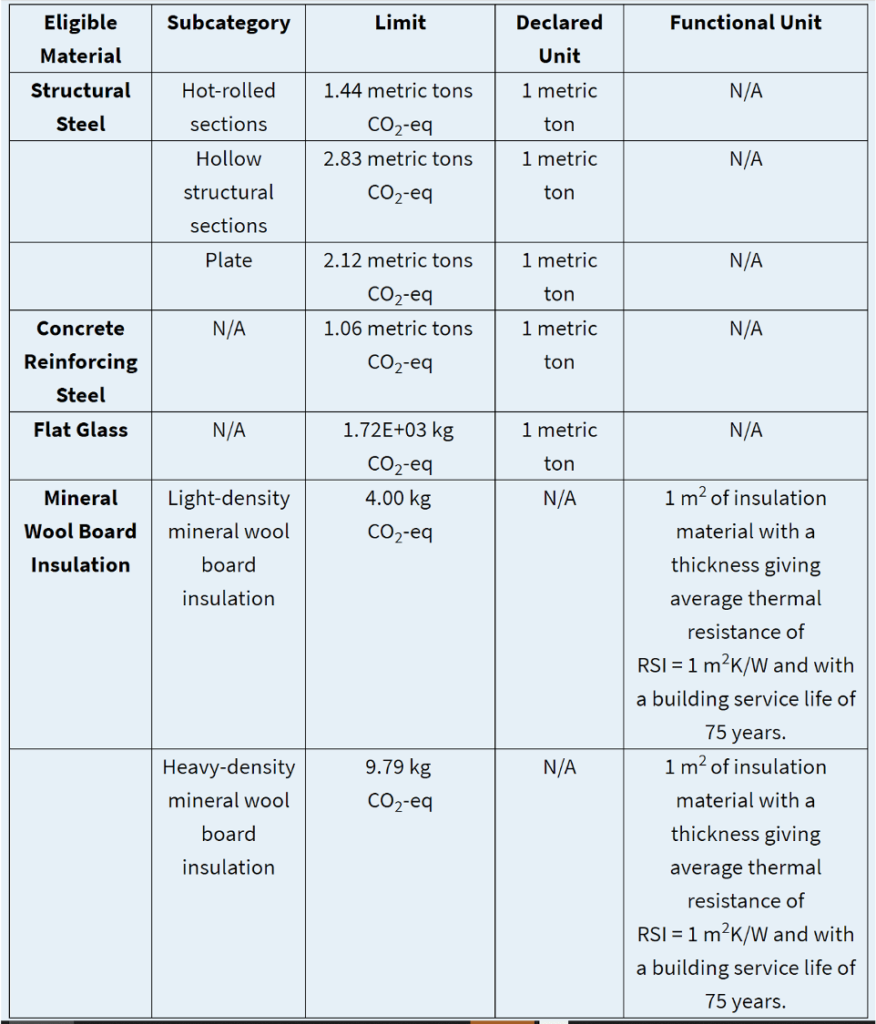California has published the carbon caps that will come into effect on July 1, 2021. These caps will set an upper limit on the embodied carbon intensity for certain construction materials purchased by the state and effectively ensures that only ‘low carbon’ suppliers and supply chains are used by California state purchases. These caps come over three years since the Buy Clean California act was adopted in the fall of 2017. The requirements currently apply to structural steel, concrete reinforcing steel (“rebar”), flat glass, and mineral wool board insulation. The state has noted that additional materials will likely be added in the future.

Figure 1: GWP limits for eligible materials. Coming into effect July 1, 2021 for California state purchases.
The heart of compliance is facility-specific environmental product declarations (EPDs) to show the embodied carbon of the applicable materials, measured in global warming potential (GWP).
The Act was phased-in to first ask (2019), then require (2020) facility-specific EPDs without a GWP cap. These initial years provided industry time to decarbonize and also prepare compliance documentation in the form of facility-specific EPDs. The State used the data collected over these years to understand the range of carbon intensity found in these materials being specified for California state-funded construction projects.
On January 1, 2021, the GWP cap for each eligible material was published. These caps were calculated as the average value collected over the previous two years plus a ‘tolerance’ to account for uncertainties. This tolerance varies by material type as follows:
| Eligible Material Category | Tolerance added to the industry average value | State notes on tolerance |
| Steel: hot-rolled sections and plates | 35% | Due to uncertainties and lack of representation of steel imports |
| Steel: hollow structural sections | 20% | Due to uncertainties coming from global production values |
| Steel: concrete reinforcing | 15% | Due to uncertainties |
| Flat glass | 20% | Due to uncertainties |
| Mineral wool board insulation | 20% | Due to uncertainties |
The published limits are based on production and exclude fabrication. It is therefore important to ensure any EPDs used to demonstrate compliance show the production values only, excluding fabrication such as welding, drilling, or finishing, where possible.
Valid EPDs must be:
- From a facility-specific manufacturer
- Independently verified in accordance with ISO 14025 (Type III environmental declarations – Principles and procedures)
- Developed according to the guidelines of the applicable Product Category Rule (PCR) as identified by DGS
- Validated by a date that has not expired
- Represented as an eligible material
An EPD must not be:
- An industrywide/industry-average product declaration
- A fabricator’s product declaration
- An average reported GWP from multiple manufacturing facilities
The GWP limits are planned to be updated on January 1, 2024 and every three years thereafter. The limits will be adjusted downward to account for industry decarbonization. This strategy leads to continuous improvement and decarbonization of the industries covered by the Act.
More Buy Clean Legislation Coming
Although California is clearly the leading buy clean jurisdiction in North America, it is sure to get company in the not-to-distant future. Numerous other states including Washington and Oregon have introduced similar legislation that has yet to pass into law. Municipalities and agencies across North America are also considering their own Buy CLean policies.
At the US Federal Level, House Democrats have already drafted the CLEAN Futures Act which includes a federal buy clean program. With democrats posed to take control of the legislative agenda in Washington DC later this month, many see some type of federal Buy Clean program on the horizon.
Need help with Buy Clean compliance?
Contact us today for guidance on meeting current Buy Clean legislation. We also help develop new Buy Clean legislation for jurisdictions interested in reducing their embodied carbon emissions.

